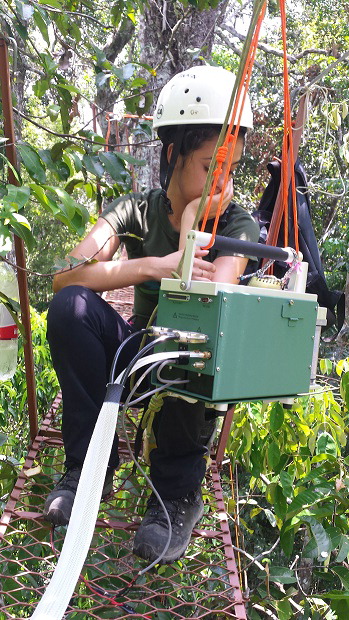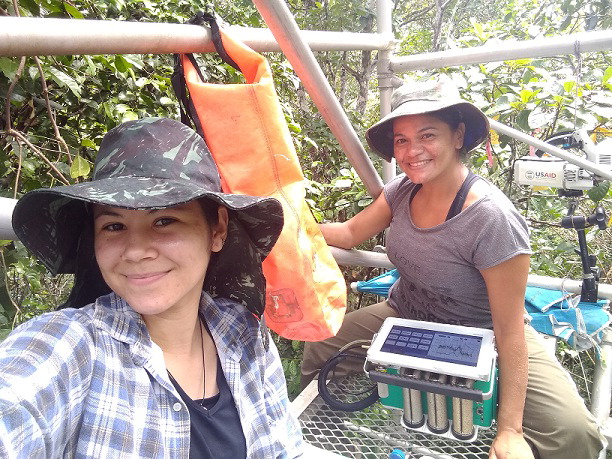|
Cycle 4 (2015 Deadline)
Functional diversity of interrelated photosynthesis and water use of Central Amazonian trees
PI: Tomas Domingues (tdomingu@gmail.com), University of São Paulo
U.S. Partner: Pierre Gentine, Columbia University
Project Dates: November 2015 - July 2022
Project Overview 
Team member Maquelle Garcia takes measurements at the top of the tree canopy (photo courtesy of Dr. Domingues). | This project will generate novel understanding on the diversity of plant traits related to water use and photosynthesis. The functional diversity present in a given community is a key dimension of biodiversity that effectively modulates how forests respond to disturbances, such as logging, precipitation, and temperature extremes or the increase in carbon dioxide concentration. It also determines the extent of the feedback between forest and climate, therefore informing us on possible consequences of forest mortality or land use change. To better predict the resilience of the forest and its capacity to provide ecosystem services, it is essential to evaluate the current spectrum of functional diversity, still a major unknown component in biodiversity research. Dr. Domingues and his colleagues will use a new approach looking at the carbon and water cycles as fundamentally coupled at both the leaf and tree level. In order to achieve a qualitative and quantitative assessment of water and carbon strategies by Amazonian trees, they will continuously monitor both the transport of water in tree trunks and the continuous expansion and contraction of the tree’s bole diameter, which relates to water storage, mobilization of photosynthetic products, and growth. This will be complemented by leaf-level measurements of photosynthetic apparatus and hydraulics to comprehend the individual link of photosynthesis with water usage. This novel dataset will demonstrate the coupling between transport of water and carbon within trees and how it relates to forest productivity. The new data will be applied to broader scales by using land-surface and ecosystem models to simulate the interaction between forest and atmosphere at different scenarios of functional diversity. This step will be achieved by collaboration with U.S. Government-supported partner Pierre Gentine, who is implementing a soil-plant-atmosphere-continuum model able to reproduce the carbon and water relationship in the Community Land Model. Brazilian students will also receive much-needed training in computational modeling.
The proposed research will shed light on the role of biodiversity not only in maintaining and improving quality of life for inhabitants of the Amazon region but also for improving water security in other areas. By characterizing current variability in water and carbon use strategies expressed by Amazonian trees, it is possible to assess how much biodiversity loss within this group is tolerable, without seriously compromising ecosystem functioning. The information to be generated by this project will help in evaluating ecosystem integrity in areas where disturbance has already occurred. For example, it will be possible to assess disparities between pristine forest and secondary vegetation, in terms of ecosystem response to water stress whether from bottom up (soil to leaves induced by dry soil conditions) or top down (from leaves to soil induced by dry or hot weather conditions), according to species composition of the community. As a result, plant communities can be evaluated in terms of resilience to further climatic extremes. The products of this research will also aid in guiding species selection for vegetation restoration efforts. For example, such information will be of great value to local community initiatives focusing on production of tree saplings for reforestation programs or ecosystem improvement actions.
Final Summary of Project Activities
 | Two Master’s students from INPA´s Post Graduation Program on Tropical Forest Sciences
carry out field work in the Amazon: Julyane Pires (left) and Ana Gracy Ribeiro (right). Photo courtesy of Dr. Domingues. | This project supported extensive field work in the Amazon that, in addition to the many research outputs, provided valuable hands-on training for students to develop their skills in tropical ecophysiology. The PI Dr. Domingues notes that the financial support provided by PEER enabled several students to start their careers studying the tropical rainforest biome. His team included 12 students (four postdocs, a PhD student, four Master’s students, two undergraduates, and a technician), 75% of whom were female. One highlight of the project was the successful PhD thesis defense of Dr. Maquelle Garcia, who worked on the PEER project since its early days, beginning as a Master’s student and completing her PhD research with PEER support. She had her first manuscript published by the Journal of Experimental Botany (see citation below) and had two more manuscripts in preparation at the time of the final report on the project. Maquelle accepted the offer of a postdoctoral position in the United States beginning in January 2022.
Thanks to PEER funds, Dr. Domingues and his team obtained several key pieces of equipment, including a gas exchange monitoring system, a portable photosynthesis measurement device, and 100 high-precision automated dendrometers. One important aspect of this project involved monitoring a large number of tree species (about 100) to determine their water use behavior. Through transpiration, trees transfer large amounts of water from the soil to the atmosphere. This transpired water helps maintain high precipitation rates within the Amazon, but it also exports some moisture to other regions of South America. The PEER team used their new automated high precision dendrometers (also called “tree huggers”) to gather useful data efficiently. The quality of their work has been reflected in several publications in high-impact journals. A list of the most recent major publications associated with PEER support is included below.
Although the PEER project has ended, Dr. Domingues and his group will continue their work in the Amazon, working in partnership with colleagues from other Brazilian universities through their involvement in the AmazonFACE program (https://amazonface.unicamp.br/en/).
Publications - Oliveira TCdeS, Garcia MN, Veenendaal E, Domingues TF. 2023. Extending the ‘onepoint method’ for estimations of leaf photosynthetic capacity to a broader temperature range. Journal of Experimental Botany 74(3): 684-697. https://doi.org/10.1093/jxb/erac466
- Nishiwaki A, Moura M, Galvíncio J, Oliveira C, Silva E, Lima J, Antonino A, Souza E, Menezes R, Montenegro S, Domingues TF. 2023. Uso do LiDAR na Estimativa de Atributos Florestais: Uma Revisão. Revista Brasileira de Geografia Física 16(1): 505-527. DOI:10.26848/rbgf.v16.1.p505-527
- Díaz S, Kattge J, Cornelissen JHC et al. 2022. The global spectrum of plant form and function: enhanced species-level trait dataset. Sci Data 9, 755. https://doi.org/10.1038/s41597-022-01774-9
- Dong N, Prentice IC, Wright IJ, Wang H, et al. 2022. Leaf nitrogen from the perspective of optimal plant function. Journal of Ecology 110: 2585-2602. https://doi.org/10.1111/1365-2745.13967
- Ellsworth DS, Crous KY, De Kauwe MG, et al. 2022. Convergence in phosphorus constraints to photosynthesis in forests around the world. Nature Communications 13, 5005. https://doi.org/10.1038/s41467-022-32545-0
- Cunha HFV, Andersen KM, Lugli LF et al. 2022. Direct evidence for phosphorus limitation on Amazon forest productivity. Nature 608: 558-562. https://doi.org/10.1038/s41586-022-05085-2
- Domingues TF. 2022. Stomata secretive ways: A commentary on Lamour et al. (2022). Global Change Biology 28(11):3484-3485. https://doi.org/10.1111/gcb.16184
- Menezes J, Garcia S, Grandis A, Nascimento H, Domingues TF, et al. 2022. Changes in leaf functional traits with leaf age: when do leaves decrease their photosynthetic capacity in Amazonian trees? Tree Physiology 42(5): 922-938. https://doi.org/10.1093/treephys/tpab042
- Giles AL, Rowland L, Bittencourt PRL, Bartholomew DC, Coughlin I, Costa PB, Domingues TF. ET AL. 2022. Small understorey trees have greater capacity than canopy trees to adjust hydraulic traits following prolonged experimental drought in a tropical forest, Tree Physiology 42(3): 537-556. https://doi.org/10.1093/treephys/tpab121
- Garcia MN, Hu J, Domingues TF, Groenendijk P, Oliveira RS, Costa FRC. 2022. Local hydrological gradients structure high intraspecific variability in plant hydraulic traits in two dominant central Amazonian tree species. Journal of Experimental Botany 73(3): 939–952. https://doi.org/10.1093/jxb/erab432
- Sampaio G, Shimizu MH, Guimarães-Júnior CA, Alexandre F, Guatura M, Cardoso M, Domingues TF, Rammig A, von Randow C, Rezende LFC, and Lapola DM. 2021. CO2 physiological effect can cause rainfall decrease as strong as large-scale deforestation in the Amazon. Biogeosciences 18, 2511–2525. https://doi.org/10.5194/bg-18-2511-2021
- Fleischer K, Rammig A, De Kauwe, MG, et al. 2019. Amazon forest response to CO2 fertilization dependent on plant phosphorus acquisition. Nat. Geosci. 12, 736–741. https://doi.org/10.1038/s41561-019-0404-9
- Smith NG, Keenan TF, Prentice IC, et al. 2019. Global photosynthetic capacity is optimized to the environment. Ecology Letters 22(3):506-517. https://doi.org/10.1111/ele.13210
- Pereira IS, et al. 2019. Performance of laser-based electronic devices for structural analysis of Amazonian terra-firme forests. Remote Sensing 11:510. https://doi.org/10.3390/rs11050510
- Domingues TF, Ometto JPHB, Nepstad DC, et al. 2018. Ecophysiological plasticity of Amazonian trees to long-term drought Oecologia 187: 933-940. https://doi.org/10.1007/s00442-018-4195-2
Back to PEER Cycle 4 Grant Recipients
|





